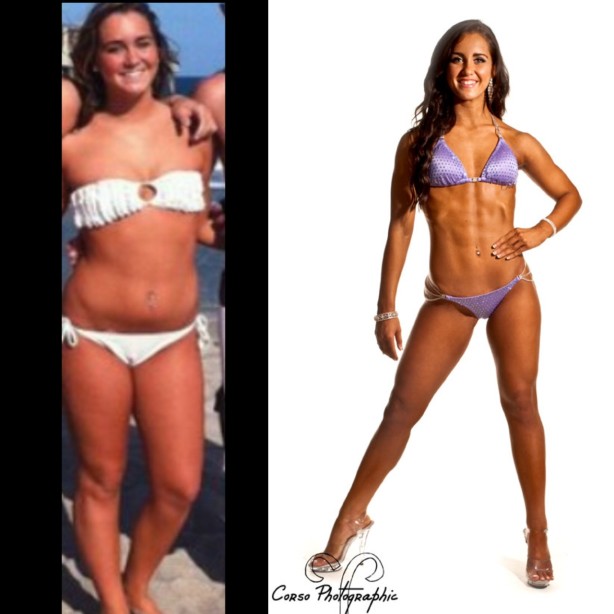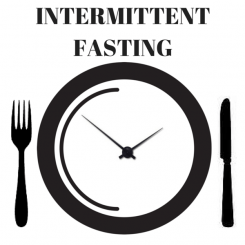Is fasting the same as slowly starving to death?
If so, then why are health experts and trainers recommending it?
At face value, not eating can certainly help in the caloric deficit department. IF (intermittent fasting) is more than just that, though.
Read on and find out how you can benefit from intermittent fasting and how to do IF the right way.
First, a Little Backstory…
Growing up, I always thought that fasting was for those who were sick and needed to do something so drastic that they had to abstain from all kinds of food.
A few years ago, I re-discovered the eating program and it totally changed my perception of intermittent fasting. Turns out, IF isn’t about saying no to food but rather choosing a form of eating that can provide long-lasting health benefits!
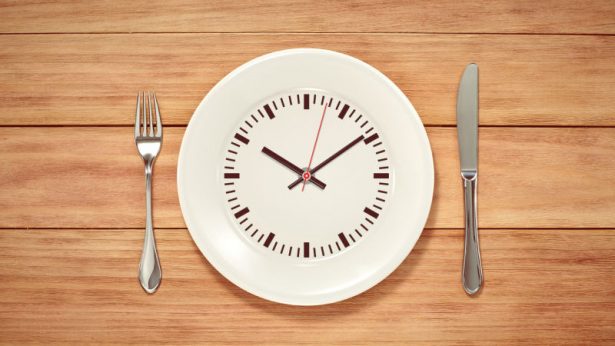
Related: Intermittent Fasting: The Easy Three Meal Plan
So, What is Intermittent Fasting Really?
The simplest definition of intermittent fasting I can think of is this- you are not allowed to eat anything within a set window of time.
That window of time is flexible and can be changed depending on several factors (which we’ll talk about later).
Naturally, your body will go into shock when you suddenly go cold turkey, and for this reason, I’d recommend you choose the smallest window to start.
Other than that, the length and time will depend on your lifestyle and personal preference. IF eating plans can range anywhere between 16 to 36 hours, and each one has a unique set of benefits for your body and overall health.
Why Should You Try Intermittent Fasting?
If you’re asking, ‘can intermittent fasting help me lose weight?’, then the answer is yes.
In my opinion, it’s actually better than all those restrictive fad diets out there. You get these two long-term weight loss benefits as well:
1. IF optimizes your body and changes it into a super fat-burning machine. The hormones that control fat formation is suppressed while the hormones that stimulate fat loss is heightened.
2. Adapt IF as a lifestyle and you’re sure to gain a lean physique. It’s essentially a huge reset button on eating and helps you get rid of unhealthy habits. I love how I could eat large meals and not feel guilty about it the next day, and how it won’t affect your weight loss goals at all. The ‘no feed’ window limits caloric intake and gives your body time to rest.
Intermittent Fasting Benefits
1. A Hassle-Free Way of Restricting Calories
If you loathe the idea of counting calories and having a calculator with you at all times (yes, even when eating at a restaurant), then IF is for you.
It basically frees you up from the tedious aspects of trying to lose weight without any serious drawbacks. With fasting, you can say goodbye to hunger pangs and punishing mistakes!
2. Equips You With Appetite Control Skills
In all honesty, I think most people fail to achieve their desired body shape and weight because they couldn’t keep their stomach under control.
There’s a grain of truth in saying that hunger is a mind game. Yes, your stomach growls and you sometimes feel like you’d give anything for a double cheeseburger, but when you let that pass you’ll discover that it isn’t food that you really need.
Our body is an amazing machine and can survive without food longer than you think. What’s more surprising is that you can continue to work, train and exercise even when you don’t eat 3-5 times a day.
Unfortunately, we’re conditioned to eat frequently but there’s no benefit in doing that. Our metabolism won’t be faster and you’ll be telling your body to be hungry all the time.
3. You’ll Be Able to Do More
Less time eating means more time for other things, right?
Also, more food doesn’t equate to being more productive. A study has found that young adults can take in as little as 300 calories spread over two days and still perform well in terms of reasoning, learning, memory, choice reaction time and vigilance. What’s more, it didn’t affect their sleep, mood and daily activity.
4. Your Blood Sugar Will Thank You For It
Blood sugar levels are tied directly to obesity and chronic conditions such as diabetes, insulin resistance and pre-diabetes. One of the keys to losing weight is ensuring your glucose levels are kept within an acceptable range.
It’s a common belief that eating frequently helps manage blood sugar levels, but in reality, it’s the exact opposite. Each time you eat your blood sugar does a roller coaster ride, so it makes perfect sense to eat only one meal per day.
Sugar input can be reduced by as much as 30% with fasting. Insulin sensitivity will be improved and you’ll be able to burn fat at a more efficient rate.
5. Fat Oxidation Soars Through the Roof
Fat oxidation is a bodily process where stored fats are converted to usable energy, and usually occurs when you’re in an active state.
Interestingly enough, the same happens when you adapt intermittent fasting as your eating program. Your body activates stored fat and makes it the primary fuel for energy. The calories you burn will be from fat, which should help you get into better shape.
6. Lowers Inflammation and Improved Waste Elimination
Let’s say that you’re well within your weight and body fat range. Does it mean you won’t benefit from IF?
The beauty of fasting is that it can help everyone. Your system gets a much-needed break from that constant eating cycle and can focus on healing and eliminating accumulated waste in the body.
Also, metabolic inflammation can be the reason why you can’t get rid of excess baggage no matter how hard you try. This type of inflammation causes havoc by disrupting a number of vital processes, including metabolism.
7. Unleashes Your Growth Hormone Potential
Perhaps the biggest benefit you can get from IF is higher growth hormone production.
To the uninitiated, GHs are hormones produced by our pituitary glands that encourage cell regeneration and reproduction in humans and animals alike. Not only do you get optimum muscle and tissue growth, but also rejuvenative and fat-burning effects as well.
And if that’s not enough to convince you, more GH equals a youthful appearance and puts you in a position to build more muscle!
8. You’ll Never Experience Hunger Again
Yes, I know this sounds like click-bait and that it’s too good to be true, but hear me out for a second.
Imagine never feeling hungry again. Wouldn’t it make losing weight so much easier? I said before that hunger pangs are a dieter’s worst enemy because they break your will and resolve. Hunger can also make you moody, distracted and irritable.
Ghrelin is the hormone responsible for hunger pangs. If you can resist the effects of ghrelin then you’ll have complete mastery over it. Intermittent fasting is one of the best ways to do this- delay the response and even when you’re pumping ghrelin you won’t succumb to it.
Having ghrelin coursing through your body is not a bad thing. For one, it encourages the production of growth hormone. Longer periods of fasting equal higher amounts of GH for the ultimate in fat burning and healing!
Intermittent Fasting Methods
Intermittent fasting can be interpreted a dozen different ways depending on who you ask. To help you in your quest I’ll be listing only the most popular ones and provide a brief description on how to do them.
As long as you’re following the time window rules you should be getting the benefits. I’d recommend you give all the methods a do-over and see which one fits your goal and lifestyle.
Ease into IF gradually with the Leangains method if it’s your first time with the eating plan. After a week or two you’ll have conquered the hunger pangs and can transition to the method you want.
Let’s dive into the world of intermittent fasting, shall we?
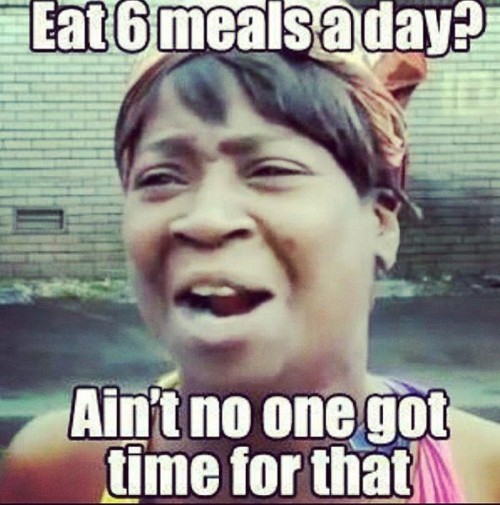
The Alternate-Day Feasting Method
(12 hour feed and 36 hour fast)
Created by Dr. Michael Eades, the ADF can be defined by a simple, easy-to-follow stratagem- you eat one day, then skip one day.
Let’s say you want your feeding time to be between 9 am to 9 pm. Starting Monday at 9 pm until Wednesday at 9 am you’ll be fasting, then feed until 9 pm and fast until Friday at 9 am, and so on.
Technically, there aren’t any food restrictions when doing intermittent fasting but you’ll want to eat as healthy as you can to maximize its effects.

The Meal Skip Method
(Random)
The meal-skipping method may sound chaotic and well, random, but there are a few hard rules that you must follow.
To do the meal skip you’ll have to think like a caveman. Our ancestors didn’t have the luxury of eating every day, and food those days were hard to come by. Moreover, they had to make do with what was available to them, e.g., fruits, nuts and the occasional meat.
That said, evolutionary-friendly food and skipping dinner or breakfast once or twice per week are recommended, as are caloric cycling.
The Eat, Stop Eat Method
(Once or twice fast of 24 hours every week)
Eat Stop and Eat by Brad Pilon is somewhat flexible on both time and food choices. Still, it’s better to eat sensibly rather than just mindless gorging because you know, health.
Each week you get to pick a 24-hour fasting window. For example, if you want Monday’s dinner to be your last meal, then you can pick 8 pm Monday until 8 pm Tuesday as your option. You can opt to have Wednesday’s 9 am breakfast as the start of the 24 hour fast and end it Thursday at 9 in the morning.
The Leangains Method
(8 hour feed and 16 hour fast)
Probably the easiest IF method to start with if you’re new to the program. You’ll have to do a bit of math though, and follow a few ground rules.
Carbs in all its forms must be cycled and most of the foods you eat should have high protein content. Fasted training is a must, coupled with nutrient timing, i.e., eating after exercise.
You can follow this as an example. You start the fast on Monday at 9pm and end it on Tuesday at 1pm. Training can be scheduled at 12pm Tuesday, and you’ll need to supplement with BCAAs, or branched-chain amino acids during training. Feeding time is done between 1pm to 9pm Tuesday, but the biggest meal is done at 1pm.
Do the cycle again for the next day and continue as necessary.
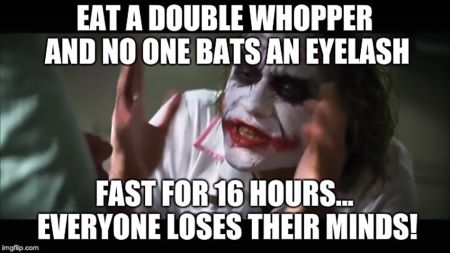
The Warrior Method
(4 hour feed and 20 hour fast)
Ori Hofmekler’s IF method will have you eating in a small 4-hour window and working out anywhere within the 20-hour fasted window.
You won’t be tracking days with this method. Instead, you can choose the window depending on your lifestyle. Is dinner with family the most important time of the day? Do you work nights or have a set training program you’d like to follow?
The fasted and feeding windows are flexible and can be tailored to your liking. You can also choose the food, but if it were me I’d go with the good (read: nutritious) stuff!
My Intermittent Fasting Experience
After doing IF for nearly a whole year I’d have to say that I’ve never felt and looked better!
Till now I regularly fast using the Eat, Stop Eat method, but just like my friends, I began with a simpler form of Leangains. I prepared for the eating program by doing a 5-day cleanse and planned ahead with meals for one week.
By Monday, I took the plunge officially after breakfast. For someone who was new to fasting, I was worried that I wouldn’t last the day, but somehow I powered through and broke it the next morning.
I noticed almost immediately that I could control my hunger pangs better. I was also able to digest my food more thoroughly. After a few days, I experienced having more energy, focus and stamina during training sessions. I could go a whole day without food, take only BCAAs, cod liver oil and water and feel perfectly fine.
As someone who works out a lot, I’d have to say that the Lean Gains method was the right fit. I’m the person who can function efficiently even when I haven’t eaten, and the BCAA powders do fill in the gaps quite nicely. A hearty meal right after a tough workout serves as my reward and keeps me honest, too!
You can copy my Leangains program if you want, but feel free to tailor it according to what you need. I end my last meal at 8 pm, sleep and wake up to a breakfast of BCAA powder and a glass of water. A few hours before the feeding window opens I hit the gym and work out.
After training ends, I take another serving of BCAA powder and fruit juice or water. I prepare a shake for lunch, then follow it up with lots of protein and fat a few hours later (somewhere around 3 to 4 pm). I follow the dinner routine and start the fasting cycle all over again.
It may sound complicated but it’s really not. I love how I get more energy and become more productive during the day. Meal prep became a matter of what I’d eat twice instead of four or five times. Best of all, I could eat anything I want and not have to pay a price for it.
Here’s a sample meal plan for you:
Morning
Water, green tea or black coffee.
During and After Workout
A scoop of BCAA (branched-chain amino acid) supplement. Plenty of water to hydrate.
First Meal
A super shake that consists of whey protein powder. You can eat some fruit and a tablespoon or two of cod liver oil.
Second Meal
Your first real meal of the day. I’d recommend a serving or two of vegetables, a cup of Greek yogurt or meat (max 8 ounces) and a handful of almond or peanut butter.
Third Meal
This will be your dinner and last meal of the day. I’d recommend a serving or two of vegetables, meat (max 12 ounces), functional carbs like potato, sprouted grains or quinoa and a tablespoon of extra virgin coconut oil or virgin olive oil.
Follow this at first to ease into the fasting experience, then once you’re acclimated feel free to experiment with the meals on your own. You’ll love the flexibility of the eating program and the wiggle room it provides in terms of daily nutrition!
Weight loss? Check. Eliminating hunger pangs? Check. Having higher growth hormones for maximum muscle gains? Check. Intermittent fasting can certainly give you these benefits, but the more important thing is that you gain them for a lifetime when you adapt it as a lifestyle.
Think about it. A diet that restricts you to eating like a goat or one that rewards you simply by sticking to a time window? Experience the wonders of intermittent fasting today!

Ryan is a former college wrestler and lifelong fitness fanatic with over 25 years in the industry. He’s run half marathons, tackled mud runs, placed in body transformation contests, and coached everything from wrestling to girls’ soccer.
Along the way, he’s tested hundreds of supplements and built a deep well of supplement knowledge. His work has appeared in Muscle & Strength, Testosterone Junkie, The Sport Review, and more. Today, he’s the editor-in-chief of this site, still training hard and helping others reach their goals. Connect with him on LinkedIn below.

